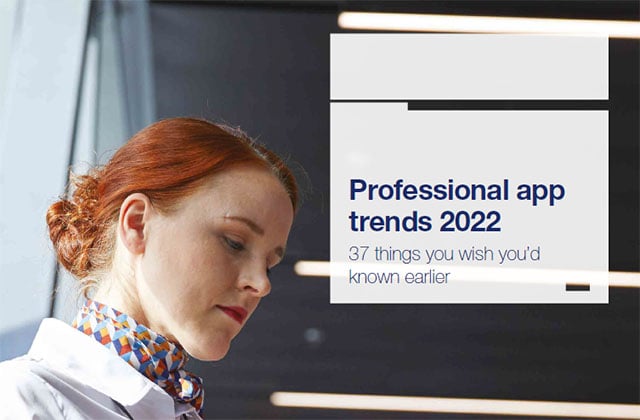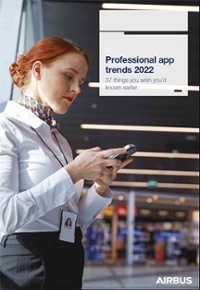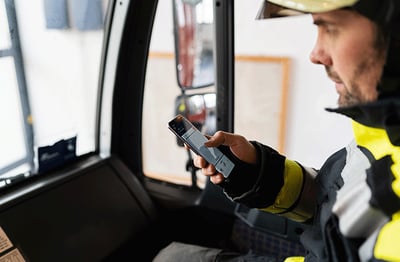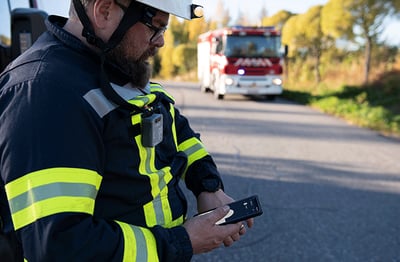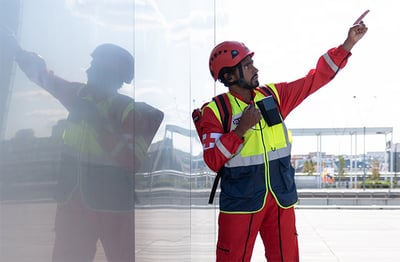Think back 20 years. The TETRA Touch customer magazine introduced 15 applications in its issue 4/2002. These applications included recording and email over TETRA. It also mentioned e-Policing and passenger transport management.
Do these apps seem too modern for 20 years ago? Let’s look at app trends back then, a little while ago, and today!
20 years ago
20 years ago, TETRA Touch customer magazine 4/2002 said the following about mobile apps:
“Fast data transfer is increasingly important in the world of wireless mobility, the Internet and multimedia messaging. Users want the benefits of applications such as transferring images and video clips or digital mapping.”
According to the 2022 mobile apps survey by Airbus, professionals today value fast data transfer as much as they did 20 years ago. Users expect that apps will be more or less the same as today, only faster.
Twenty years ago, we could not have imagined the masses of information that travels over the air today. This is often live video rather that short clips. It is also sent all the time, and nearly everywhere in the world.
Many respondents to the survey mentioned more and richer data, such as videos – also in real time – and completely new opportunities. They expect more efficient, more advanced apps for the Internet of Things. They also expect mission-critical push-to-talk on broadband.
The report shows the top three types of apps that organizations want:
- Applications to automate routine tasks and reporting
- Group chat (group messaging)
- Field commanding.
So, the prediction from the past was not completely off target. Rich media sharing to a group (images, files, video clips) has been growing from the 2020-2022 surveys. In the latest survey, 15% of respondents mentioned it as one of the three types of apps they want.
What about 15 years ago?

The 1/2006 issue of Key Touch predicted the following:
"Globalisation, the age of uncertainty, the increasing speed of operations, and the changing shape of work are all examples of trends that will have a direct impact on us. Although we cannot know what’s coming next, we can use these trends to pose a series of ”what if” questions. This way, the future may become somewhat less of a surprise."
Everyone will recognize these four megatrends. Because of the Covid-19 pandemic, work has changed even more than anyone imagined! Many people worked remotely during the Covid-19 pandemic. This has led organizations to create new ways of working.
Handpicked related content
If you do not want the future to surprise you, take a look at the survey report:
Professional app trends 2022 - 37 things you wish you'd known before
Over 500 professionals like yourself shared their views in the 2022 Airbus survey. The survey report reveals interesting insights and some surprises. For example, what is the most surprising accessory to use with mobile apps in 2022?
11 years ago
In 2011, Key Touch customer magazine made this prediction:
“In the not-so-distant future, role-oriented communications, live reporting and intelligent task management will all be available, thanks to a plethora of value-adding applications that can be tailored and customised to meet the needs of different organisations.”
Sounds impressive… but what does the survey say?
Reporting is the most wanted app. Respondents want to make reporting and administrative tasks easier and do them while on the move.
16% of respondents reported that they use applications to automate routine tasks and reporting (a new option this year). This also received most replies to the question “What are the most likely types of apps that your organization would introduce?”
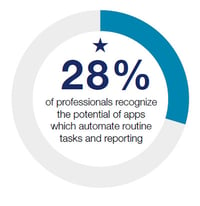 Reporting is important for professional users. 28% of professionals recognize that apps can help with routine tasks and reporting. These apps must also offer security and allow users to keep control of their data.
Reporting is important for professional users. 28% of professionals recognize that apps can help with routine tasks and reporting. These apps must also offer security and allow users to keep control of their data.
Also, when asked “Which operations or tasks would you prefer to perform with an app instead of your current way of working?”, reporting got most mentions. This included approving reports remotely, generating reports and analysing data.
The same Key Touch article from 2011 predicted apps that anyone would welcome. How do these “everyone’s favourites” rank against the reality today?
Everyone’s favourite 1: Video aggregator
A command centre can pull together civilian video clips of an incident from the web and send them out to field officers, enabling them to see the situation from multiple perspectives.
Such a video aggregator might help field officers get a better view of the situation. Perhaps in the future, an AI agent at the command centre could perform this task. But would it be legal to process and share civilian video clips in this way?
According to the 2022 survey, apps related to Artificial Intelligence, (biometric apps), and sharing rich media with groups are becoming more popular. And 6% said they already use applications related to Artificial Intelligence.
When asked the question “What are the most likely types of apps that your organization would introduce?” more people are mentioning rich-media sharing to a group.
![]()
Everyone’s favourite 2: Time for a break
Even the most rugged field agent has to eat. The “find a restaurant” app on commercial smartphones is a great example of the kind of application that could benefit professional radio users just as much as the rest of us.
If field agents use smartphones, they could use commercial apps to find a restaurant for their lunch break. However, would this be acceptable on their duty phone? And would they be allowed to share their location information with a commercial app?
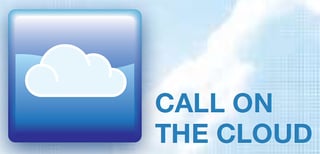
Everyone’s favourite 3: Call on the cloud
Field officers can access tactical information remotely, such as the history and profile of a suspect in a hostage negotiation. This cloud-based approach reduces the need for data storage on the terminal [device].
According to the survey report, officers may not be ready to use the cloud - around 39% of the respondents would NOT trust their critical data being stored on an external cloud service.
However, almost 44% of the respondents would trust the cloud – this is an even larger percentage than in the previous survey from 2021.

10 years ago -
Key Touch magazine 3/2012 made a statement that is relevant even today:
“Future critical communication networks must be able to deliver voice and multimedia the way that professionals need to do their jobs well.”
Two of the requirements for “the digital future” can be compared to the findings from this year’s survey.
First responders want more media
First responders will find media-rich information extremely useful. Broadband and Emergency Response Solutions ERS with multimedia capabilities are key for sharing this information, but technology is not the only thing that matters.
Users today do not consider emergency response solutions as key for sharing multimedia. This is because the option “Solutions are integrated with command and control rooms” is the least popular answer to the question “What are the most important characteristics of professional mobile apps?”
This option has been chosen by fewer and fewer people since 2016 when the survey was first conducted.
Although first responders find media-rich information useful, they value security and ownership of data as most important.
Another requirement from a decade ago – according to Key Touch magazine 3/2012 - was ease of use. It was listed as an essential requirement. This makes sense because professionals on the move need to focus on the task and not on their tools.
However, today’s respondents see it as only the third most valuable characteristic. While security reigns supreme, high reliability and availability of the service is more important than ease of use. This has been the case throughout the seven years of the survey.
6 years ago
Let’s take one more throwback. Key Touch 2/2016 reported on the findings from the first-ever mobile apps survey.
“And what about the next big thing in apps for professionals? Users showed a big interest in positioning apps, while there is still good market potential to develop messaging apps.”
In the 2022 survey, reporting is the most wanted app. Respondents want reporting and administrative tasks to be easier. They also want to do them while on the move. They need mobility.
The survey also finds that professionals want group chat or group communication. They want to have push-to-talk (PTT) on their smartphones. They recognize that smart devices and apps can help them be more efficient.
Discover more trends and learn 37 things you wish you’d known earlier: take a look at the latest trends in professional apps, identified by the seventh Airbus survey:
Sources: TETRA Touch 4/2002, Key Touch 1/2006, Key Touch 2/2011, Key Touch 3/2012, Key Touch 2/2016, and “Professional app trends 2022” – the 2022 mobile apps survey report
You will find all professional app survey trends and reports since 2016 conveniently in one place: https://www.securelandcommunications.com/professional-app-trends

